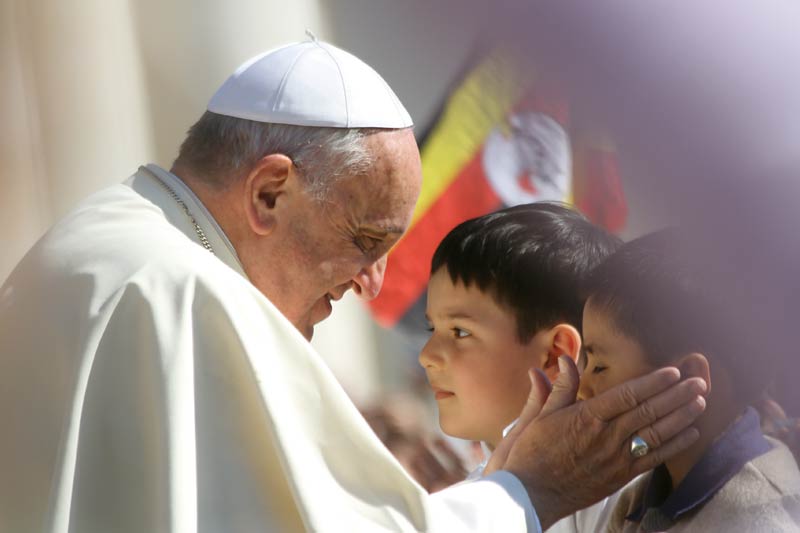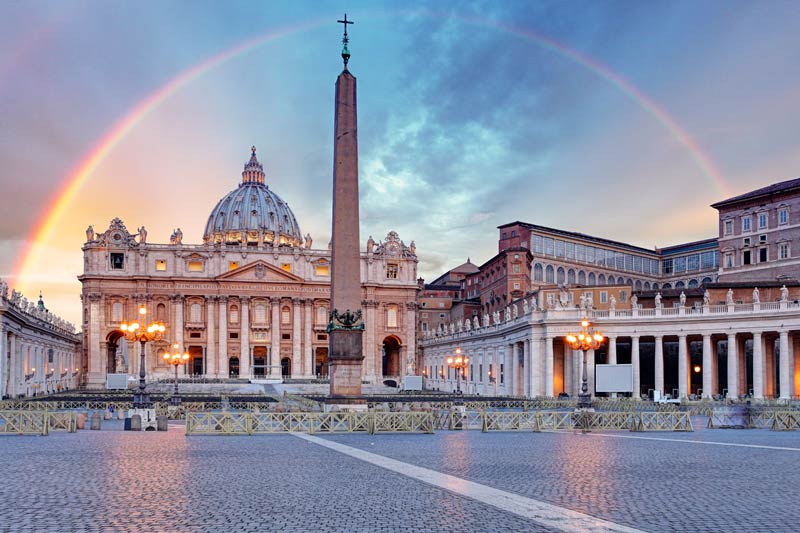Beginning with media commentary on Dr Ben Carson’s religion and views, and scholars’ criteria for the identity of the Antichrist, our study has analysed in two previous articles the scandalous possibility that the apocalyptic Antichrist is the papacy itself, the axis of historical Christianity.
We conclude this series of articles (the first two of which were “Ben Carson, the Pope, the USA and the Antichrist” and “The Antichrist”) with an apocalyptic scenario centred on the role of the false prophet of Revelation 13 and how the world will be deceived into worshipping the creature instead of the Creator.
The lamb prophet with the voice of a dragon
The pseudo-prophet of Revelation 13 has usually been left out of the interpretation of Revelation by commentators. Protestant commentators, who saw pagan Rome as the first beast, identified the second beast (the false prophet) as the papal Antichrist. The Jesuit Lacunza argued that the false prophet was the fallen Catholic priesthood[1].
Some would like to uncover in the image of the pseudo-prophet of Revelation 13 the belligerent prophet of the “religion of peace.” Yet Islam is very old, it is by definition a totalitarian theocracy, and it has dangerous horns, not the little horns of a lamb. Historicist commentators have often seen the historic onslaught of Islam in the invasion of the scorpion-like locusts, or that of the horsemen of hell in Revelation 9, but not in the false prophet of Revelation 13. On the other hand, it is interesting to note that the Qur’an also foresees the eschatological rise of a beast from the earth, although in a beneficial role.
The false prophet is described as rising from the earth, just as the Antichrist beast is described as rising from the sea. And the activity of the false prophet, as described in the prophecy, explains the restoration and overall success of the Antichrist beast. This aspect of late entry into the role, as well as the youth suggested by the little horns, shows that the false prophet must be a power emerging in modern times.

A number of Protestant commentators in the seventeenth and eighteenth centuries identified the false prophet with an inconsistent Protestantism that was already imitating Rome[2], and since the nineteenth century, Adventist commentators have pointed to “Protestant Rome” (USA) with its two traditional forces: republicanism and Protestantism—in other words, civil liberty and religious liberty, or the separation of church and state[3].
According to the same commentators, the pseudo-prophet beast rises from the “earth” (the discovered continent, the New World, the land of freedom) through local development, in contrast to the rise of the Antichrist beast from the “sea” (the Euro-African-Asian Old World, with its populations tormented by wars and successive empires).
The pseudo-prophet’s specialisation in miracles is said to refer to the American appetite for the extraordinary in the religious (spiritualism, charismatic movements), esoteric (paranormal, the occult), techno-scientific, and military fields. In the Adventist scenario, the fact that the New World false prophet addresses “the inhabitants of the earth” and imposes the universal cult of the Old World usurper of Christ[4] confirms that the false prophet is a reference to the role that the First World power will assume.
The project of a new political idol
In the Adventist interpretation, the false prophet will propose to the world the creation of an “image of the Antichrist beast”, namely a political-religious system modelled on the old theocratic regime of the Old World.
The false prophet will first make this pagan idol and then embellish it to give it power and authority. Thus, the concept of a “New World Order”, regardless of what the original design of the freethinkers and freemasons may have been, would be realised in this Caesaropapist theocracy, in which America would play the role of the Caesars. However, this order will be neither new nor superior, but a copy of the pagan-Christian system of the “converted” Roman Empire and the old regime in Europe and the colonies.
This apocalyptic scenario reminds us of the Babylonian figure of Daniel 3. In Revelation, however, the “face” of the beast is not an inert idol, but a living one, with power and authority, speaking and asserting itself before the world. Under the threat of economic boycott and capital punishment[5], the living image of the beast will impose a test of loyalty to the “new” pre-Christian order.
Read the previous article of this series:
The Adventist interpretation seems straight out of a horror film. Political scientists and futurologists will probably agree that this scenario is far-fetched. As an Americanophile and someone who appreciates the steps towards normality taken by the Vatican in the last generation, I wish that this scenario remained the nightmare of sectarians with persecutory delusions. Let this prophecy fail, why not, as others have failed[6]!
Unfortunately, however, this is an apocalyptic unconditional prophecy in which the only chance of avoiding the scenario is to have formulated it wrongly. It is indeed bizarre and shocking to suspect that it is the United States, the land of freedom and the traditional home of dreamers, that will play the shameful role of restorer of the old regime, on a global scale. However, the truth is that even the events of the past, foretold by the biblical prophets, were of this very nature.
How credible was the existence of the great empires—Persian, Macedonian, Roman—a few generations before they came into being? Who could have imagined, centuries earlier, that the bishop of a ruined and deserted city would become the political key to Europe for more than a millennium?
Who could have imagined that France, the traditional backbone of papal Catholicism, would be the first to throw off the burden of the old regime and bring the secular state and secularism into the world? Who would have thought that in a modern world, the most advanced European nation would send millions of unwanted fellow human beings, particularly Jews, to the gas chambers and crematoria?
What greater evil could come?
After so many prophetic miracles in history, we should no longer be surprised that the blessed country of America, liberal and with deep Protestant Christian traditions, could turn out to be the source of the final collapse of the order of this world. Revelation even hints at how this scenario will unfold, which sounds even more outlandish: the extraterrestrial dragon, the devil himself, and the whole array of demons will show their faces in our world, as they really are, in magnificent splendour, in contrast to the tradition that depicts them as black, horned and hoofed, and easily manipulated by Christian magic.

According to prophecy, the universal worship of the Antichrist includes the worship of the Devil[7]. It is absurd, however, that in the future Christian order, the devil will openly reveal himself as he is. The prophecy in Didache 16:4-8, a famous post-apostolic Orthodox writing (c. 120-180 AD[8]) that is usually disregarded in Christian theology, states that the devil will play the role of Christ: The deceiver of the world[9] will appear, claiming to be the Son of God, and will perform signs and wonders, and the earth will be given into his hands.
He will do evil things, which have not been done since the beginning of the world. Then, the works of people will pass through the trial by fire, and many will fall and perish. However, those who remain steadfast in the faith will be saved from the curse.
Then the signs of the truth will appear: first, the sign of an opening in the heavens, then, the sign of the trumpet. Thirdly, there will be the resurrection of the dead, though not of all, but as it is written: “The Lord my God will come, and all the holy ones with Him”. Afterwards, the world will see the Lord coming on the clouds of heaven.
This spectacular scenario was already hinted at in Revelation (17:10). The beast of the world has only seven heads, but the angel says that an eighth “king” will come. This is not an eighth head, so it will not be a separate world empire, but “the beast itself” (the devil), working specifically through one of the seven heads.
This suggests that the return of the old regime will be closely linked to the emergence of the devil as the political leader of the world. This would not be possible if the devil did not disguise himself. And for the spiritual and political awakening of Christendom and the whole world, the only convincing disguise would be the staging of the Parousia of Christ—of course, as expected in popular Christianity, not as described in the Bible.
The parousia of the false Christ thus appears as the culmination of the miracles of Revelation 13. All those who are unwilling to accept Holy Scripture as a sufficient law of faith and religious practice will be led to accept the universal cult of the beast. Deceived by paranormal phenomena on the one hand, and constrained by draconian laws on the other, many will accept the order that will be imposed.
It is hard to believe that these arguments will also convince Muslims, Jews, believers of Eastern religions or atheists and secularists of all kinds. But when they see with their own eyes the one who will pass himself off as Christ, transfigured in the light of Tabor, they will convert en masse. All those who reject the final warning (the Tri-Gospel of Revelation 14:6-12 and 18:1-8) will be deceived[10].
The stigma of the new order, chip or no chip
As for the mark of the universal cult of the beast, it is written only that it must be received “on their right hands or on their foreheads”[11] or in both places[12]. Many people are being frightened and manipulated with these absurd interpretations of chips, cards and RFID barcodes. Everyone is running from some chip of the beast, but very few are interested in how to find protection in God, under His seal, of which the same Revelation warns us.
Not everything about the “mark of the beast” is clear—for example, the relationship between the mark, the name, and the number of the beast[13]. Yet, two aspects are worth highlighting. First, the mark of the beast is in contrast to the seal of the “living God” (containing His name) placed on the forehead[14].
Since the “living God” is a specific designation of the Creator God, His authenticating and protecting seal would be identical to the mark of God in Exodus 31:13-17—the rest on the seventh day. The mark of the Antichrist, on the other hand, would be a kind of anti-Sabbath. Secondly, the phrase “mark on their hands or/and foreheads” should not be sought in electronic chip technology, since God has not formulated any explicit commands discouraging the acceptance of such means, which can also be forms of control.
We would do better to look for this expression in the other places in the Bible where it is used. In Exodus 13:9, 16, the same metaphor refers to a feast (in this case a feast of the Lord). In Revelation 13:16 it is applied to a feast imposed by the beast. The feast is not explicitly named, but can be identified by two arguments: 1) The Antichrist, the authority in whose name this feast is imposed, is identified with the horn of Daniel 7:25, which dared to “change the set times and the laws” of God. It is well known that the systematic undermining of the Sabbath and, in parallel, the permanent accentuation of Sunday through canons and civil laws, created a new religious paradigm in Christendom from the first centuries onwards, and that the papacy used these very changes to justify its authority. 2) The imposition of an unprecedented feast is unlikely because we are talking about a universal cult. What is more likely is the imposition of a popular, traditional feast for the benefit of the Church. And the best candidate for this meaning is Sunday.

The order left by God at creation gives to all mankind the seventh day[15]. This is the only feast given by the Ten Commandments[16], observed by Jesus and His followers[17], and part of the covenant conditions, the Ten Commandments, by which we will be judged[18]. This is why Adventists believe that a Sunday law that defends and encourages the majority to rest, but discourages and excludes those who have chosen to obey God, is discriminatory and inhumane.
Adventists have a worldwide organisation with branches around the world to defend religious freedom. It is understood that the state must be secular and impartial in order to defend human rights. Sunday worshippers also have the right to defend their preferred day, and no one should impose another regime on them. Adventists are not fighting for the imposition of the Sabbath by law, but for states not to make discriminatory laws that would put some people in difficulty.
Most people today are economically dependent, especially those who live in cities. A Sunday law would discriminate against Sabbath workers who are already at a disadvantage. And if the law is tightened to require work on the Sabbath, punishment will surely follow, with all the evils that it entails. The prophecy foretells that those who will not accept the Sunday law will first be economically disenfranchised, and eventually, their physical destruction will be plotted.
The above scenario will unfold against the backdrop of the seven terrible plagues predicted in Revelation 16, heavenly punishments that are likely to be interpreted as coming because of the non-observance of the Sunday law. The first instigator of these socio-political evils will be the false Christ, whom the political world will recognise as God and legitimate ruler of the whole world, unfortunately.
What Adventists don’t believe about the mark of the beast
Adventists believe that conscientious Sunday observance, past or present, is not the “mark of the beast”.[19] “In the past, God overlooked such ignorance”.[20] Likewise, simply stopping work on Sunday for various reasons, including the law, while keeping the Sabbath, is not receiving the “mark of the beast”.
The future imposition of Sunday observance, which encourages keeping the church’s commandment instead of God’s commandment, is the imposition of the “mark of the beast. But only after people have rejected the warning of Scripture can it be said that they have rejected the seal of God and received the “mark of the beast”. This spiritual marking with the seal of God or the mark of the beast will be the final eschatological test and the visible criterion for the judgement of the living, who will see with their own eyes the true Parousia, the Second Coming of Jesus.
With regard to the institutions incriminated by prophecy and the people who represent them, Adventists have a paradoxical attitude, but one that must be remembered. A state, whatever it may be, cannot be blamed and demonised on the basis of what it will do in the future. Authorities are given by God, and everything that does not contradict God’s command must be respected. States are by no means “beasts”. They were left for the good of mankind and only become beasts when they violate human rights; when they are no longer humane[21].
Adventists are indebted to the American “beast” for 170 years of religious freedom. Also, for Adventists, the fact that over the last generation popes have spoken out in defence of religious freedom and in favour of free inquiry into the Scriptures, acknowledging the crimes once committed by the Catholic Church in the name of the faith, is something that deserves their respect and their prayers for a brighter future.
However, Adventists maintain that these new attitudes of the old Church are not sufficient to ensure future righteousness, and that where the causes of evil (conflicting dogmas) have not been removed, the beast instinct may reappear when conditions are favourable. Nevertheless, because Jesus is the Saviour of all people[22] and because the Adventist mission is universal and must meet everyone, Adventists have no hesitation in meeting for dialogue with official representatives of states and churches, including the highest representatives of the Roman Church, especially the Pope.
The historical reality is that some Popes have been, from a human point of view, beneficial to the Church and to the world, while others have had reprehensible attitudes, even when they no longer had the power to persecute. Yet, beyond these considerations, the man and believer who occupies the office of Pope is entitled to the respect, compassion, and prayers of us all, all the more so because the throne he occupies, as this series of articles has analysed, is a fatal one. This is how the prophet Daniel treated the harsh ruler Nebuchadnezzar, whom he respected. And, in the end, God gave the sovereign repentance and salvation of the soul.
A healthy Adventist attitude—both towards prophecy and towards those who interpret prophecy differently—is represented by Dr Jonathan Paulien, dean of the School of Theology at Loma Linda University in California, USA. Paulien is one of Adventism’s leading experts on the New Testament and the Book of Revelation. I am impressed by the erudition and depth of the exegete, and at the same time by the attentiveness, respect, and spiritual concern of the man of God, no matter how uncomfortable the apocalyptic subject he has to deal with.
Paulien disagrees with the attitude of those who are or think they are Adventists who have made it their mission to publicly denounce and demonise the papacy, based on the suspicion that all the evils of this world are the product of a conspiracy led by the Pope.
There are many beasts in this world that the prophets did not label as such, and others that we have recently encountered (fascism and communism, for example) that we did not publicly denounce enough at the time. Why should we now condemn the likeable Signor Bergoglio? Luther, with all his anti-papal fervour, expressed a great truth: “I am more afraid of my own heart than of the Pope and all his cardinals. I have within me the great Pope, Self.”[23] We cannot end here with “Hallelujah” or “Amen”, but rather with “May God protect us!”
This article is part of a series of three written by Florin Lăiu on the subject of antipapism and the possibility that the apocalyptic Antichrist is the papacy itself, the axis of historical Christianity.
In the first part, the author familiarises us with the classical Protestant perception of the concept and prophetic figure of the Antichrist, evaluating the classical identification of the Antichrist with the papacy. In the second part, the analysis continues with a careful deciphering of the main biblical prophecies concerning the Antichrist. The final part concludes with an apocalyptic scenario that focuses on the role of the false prophet of Revelation 13 and the way in which the world will be deceived into worshipping the creature instead of the Creator.




















